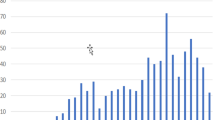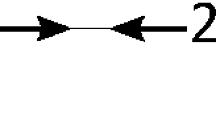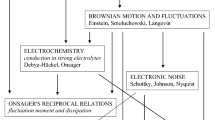Abstract
The interesting behavior of the Briggs–Raucher oscillating reaction does not stop with the end of oscillations. Depending on the initial concentrations, the classic mixture with malonic acid may undergo a sudden transition from a state with low [I2] and [I−], to a state with high [I2] and [I−]. A proposed mechanism involving radical attack on iodomalonic acid and diiodomalonic acid shows qualitative agreement with experiments.




Similar content being viewed by others
References
Briggs S, Rauscher WC (1973) An oscillating iodine clock. J Chem Educ 50:496
Shakhashiri B (1985) Chemical Demonstrations; A Handbook for Teachers of Chemistry. University of Wisconsin Press: Madison 2:248–256
Cooke DO (1980) The hydrogen peroxide-iodic acid-manganese (ii) –acetone oscillating system: further observations. Int J Chem Kinetics 12:683–698
Furrow SD (1995) Comparison of several substrates in the Briggs–Rauscher oscillating system. J Phys Chem 99:11131–11140
Furrow SD, Cervellati R, Amadori G (2002) New substrates for the oscillating Briggs–Rauscher reaction. J Phys Chem A 106:5841–5850
Furrow SD, Cervellati R, Greco E (2012) A Study of the cerium-catalyzed Briggs–Rauscher oscillating reaction. Z Naturforsch 67b:1–9
Vanag VK (1992) A new autocatalytic step in the Briggs–Rauscher reaction. J Chem Biochem Kinet 2:75–83
Furrow SD, Aurentz DJ (2010) Reactions of iodomalonic acid, diiodomalonic acid, and other organics in the Briggs–Rauscher oscillating system. J Phys Chem A 114:2526–2533
Furrow SD (2012) A modified recipe and variations for the Briggs–Rauscher oscillation reaction. J Chem Educ 89:1421–1424
Vanag VK, Alfimov MV (1993) Effects of stirring on photoinduced phase transition in a batch-mode Briggs–Raucher reaction. J Phys Chem 97:1884–1890
Vanag VK, Alfimov MV (1993) Light-induced nonequilibrium phase transition between quasistationary states of the briggs-rauscher reaction under batch conditions. J Phys Chem 97:1878–1883
Epstein IR, Pojman JA (1998) An introduction to nonlinear chemical dynamics. Oxford University Press, New York, Oxford, pp 325–327
Rojas JC, John JM, Lee J, Gonzalez-Lima F (2009) Methylene blue provides behavioral and metabolic neuroprotection against optic neuropathy. Neuro Tox Res 15:260–273
Cervellati R, Höner K, Furrow SD, Neddens C, Costa S (2001) The Briggs–Rauscher reaction as a test to measure the activity of antioxidants. Helv Chim Acta 84:3533–3547
Cervellati R, Furrow SD (2013) Effects of additives on the oscillations of the Briggs–Rauscher reaction. Russ J Phys Chem A 87:2121–2126
Čupić Ž, Lj Kolar-Anić, Anić S, Macešić S, Maksimović J, Pavlović M, Milenković M, Bubanja I, Greco E, Furrow SD, Cervellati R (2014) Regularity of intermittent bursts in Briggs–Rauscher oscillating systems with phenol. Helv Chim Acta 97:321–333
Cervellati R, Furrow SD (2007) Perturbations of the Briggs–Rauscher oscillating system by iron-phenanthroline complexes. Inorg Chim Acta 360:842–848
Cervellati R, Mongiorgi B (1998) Inhibition of chemical oscillations by bromide ion in the Briggs–Rauscher reaction. Int J Chem Kinet 30:641–646
Cooke DO (1975) Preliminary investigations of the hydrogen-peroxide-iodic acid-manganese(ii)-malonic acid oscillating system. React Kinet Catal Lett 3:377–384
Furrow SD, Noyes RM (1982) The oscillatory Briggs–Rauscher reaction. 2. Effects of substitutions and additions. J Am Chem Soc 104:42–45
Schmitz G, Furrow S (2015) Bray–Liebhafsky and non-catalyzed Briggs–Rauscher oscillating reactions. Russ J Phys Chem A: in press
Schmitz G (2011) Iodine oxidation by hydrogen peroxide and Bray–Liebhafsky oscillating reaction: effect of the temperature. Phys Chem Chem Phys 13:7102–7111
Schmitz G (2004) Inorganic reactions of iodine(+1) in acidic solutions. Int J Chem Kin 36:480–493
Turner DH, Flynn GW, Sutin N, Beitz JV (1972) Laser Raman temperature-jump study of the kinetics of the triodide equilibrium; relaxation times in the 10−8 to 10−7 second range. J Am Chem Soc 94:1554
Liebhafsky HA, Mohammad A (1933) The kinetics of the reduction, in acid solution, of hydrogen peroxide by iodide ion. J Am Chem Soc 55:3977–3986
Swartz HA, Bielski BHJ (1986) Reactions of HO, and 0,- with iodine and bromine and the 1,- and I atom reduction potentials. J Phys Chem 90:1445–1448
Onel L, Bourceanu G, Wittmann M, Noszticzius Z, Szabo G (2008) I(+1) transfer from diiodomalonic acid to malonic acid and a complete inhibition of the CO and CO2 evolution in the Briggs–Rauscher reaction by resorcinol. J Chem Phys A 112:11649–11655
Bielski BHJ, Cabelli DE, Arudi RL (1985) Reactivity of HO2/O2 − radicals in aqueous solution. J Phys Chem Ref Data 14:1041–1100
Hoops S, Sahle S, Gauges R, Lee C, Pahle J, Simus N, Singhal M, Xu L, Mendes P, Kummer U (2006) COPASI: a COmplex PAthway SImulator. Bioinformatics 22:3067–3074
Stanisavljev DR, Milenkovic MC, Mojovic MD, Popovic-Bijelic AD (2011) Oxygen centered radicals in iodide chemical oscillators. J Phys Chem A 115:7955–7958
Stanisavljev DR, Milenkovic MC, Popovic-Bijelic AD, Mojovic MD (2013) Radicals in the Bray–Liebhafsky oscillatory reaction. J Phys Chem A 117:3292–3295
Author information
Authors and Affiliations
Corresponding author
Rights and permissions
About this article
Cite this article
Furrow, S.D., Cervellati, R. & Greco, E. Study of the transition to higher iodide in the malonic acid Briggs–Rauscher oscillator. Reac Kinet Mech Cat 118, 59–71 (2016). https://doi.org/10.1007/s11144-015-0967-4
Received:
Accepted:
Published:
Issue Date:
DOI: https://doi.org/10.1007/s11144-015-0967-4




